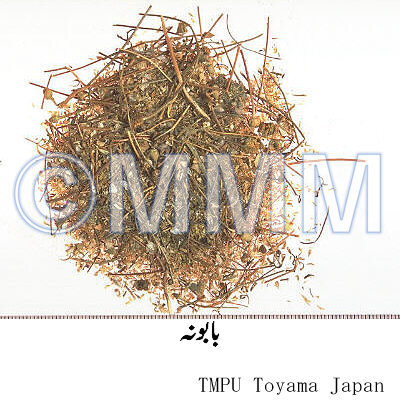Crude drug sample data base
※Click on the image to enlarge it.
The capital city, provincial capital city or the representative
location of its administrative area is indicated.
location of its administrative area is indicated.
Production area information
https://ethmed.toyama-wakan.net/img/pin_san.png
25.0700428
67.2847875
Collection information
Islamic Republic of Pakistan,Karachi [Karachi], Sind
https://ethmed.toyama-wakan.net/img/pin_nyu.png
Scientific information data base
| Crude drug name | Urudu name, English name | Babunah, Chamomile | |||
|---|---|---|---|---|---|
| Arabic name / Persian name | Babunaj, Babunaq / Karnanak, Babunah | ||||
| crude drug image |
| ||||
| Original plant name | Matricaria chamomilla Linn. | ||||
| Family name | Compositae | ||||
| Used part | Flowers | ||||
| Distribution area | An aromatic herb; native of Europe but commonly found in Punjab and U. P. states of India. It is also found in Iran, North Asia and Japan. Also in Baluchistan. | ||||
| Description | Babunaj is well known. It is a herb having flowers of different colours such as yellow, white and purple. The leaves, flowers and roots are dried up and stored. According to Galen, chamomile is nearer to the rose in tenuity but is hot, though mild like the olive. It is a delicate herb and grown in rough places and near the pathways. It is procured in spring season and stocked. The flower has a sharp taste and pleasant smell. | ||||
| Function and properties | Swellings, Joints, Organs of the head, Ocular organs, Organs of the chest, Alimentary organs, Excretory organs, Fevers. Antiseptic, sedative, anti-inflammatory, carminative, diuretic, stimulant, attenuant, deobstruent and rarefying of thick humours. It is relaxant and mild dissolvent but is not absorbent. This is its main characteristic. It is nervine emmenagogue. | ||||
| Specific actions | Anti-inflammatory and nervine stimulant. | ||||
| Frequency in use | Common in Upper Gangetic Plain (India). | ||||
| Common uses | Swellings: It soothes the hot swellings. It is administered internally in cases of severe swellings of the viscera. Joints: It reduces tension, strengthens the muscles and is the most useful drug for removing fatigue. Organs of the head: It is a tonic for the brain and is useful for cold headache and for evacuating the (humoural) matter from the head because it dissolves (humours) without absorption. It is also useful for stomatitis. Ocular organs: Its plaster is useful in diseases - as eruptive fistula, lachrimalis, conjunctivitis, turbidity, pimples, scabies, pains and itches. Organs of the chest: It is an expectorant. Alimentary organs: It removes jaundice. Excretory organs: It is diuretic, expels calculus. It acts as an emmenagogue both casas when the patient takes it internally or the patient is given sitz bath of chamomile. It expels the foetus and placenta and is useful for ileus. Fevers: A liniment (mixture of Babunaj and oil) of Babunaj is used in intermittent fevers. It is useful in fevers which are not severe. Aromatic effect and deodorant properties of chamomile flowers are so marked that it drives noxious insects and putrid smell of meat if washed twice or thrice by its infusion. Infusion is also useful for treatment (as cosmetics) of hair and scalp. Flowers oil is useful antispasmodic, imparts strength to nerves and muscles, effective against rheumatism (in application), increase bile secretion. | ||||
| Side effect | Described as harmful for throat if used in large doses or for long duration. | ||||
| Medical system | Unani | ||||
| Traditional concept | Temperament | It is hot and dry in the second degree. | |||
| Drug effect | It is a beneficial anti-inflammatory drug. | ||||
| Dosage | 1 to 3 gm. | ||||
| Substitute | Barinjasif (Achillea millefolium Linn.) or (Artemisia vulgaris Linn.). | ||||
| Corrigent (corrective) | Honey. | ||||
| Important compound preparations | Ma`jun Fotinji, Roghan Babuna and Ma`jun Filasfa. | ||||
| References | Reference book Tips! | Glossary of Indian Medicinal Plants, 1956. Chopra, R.N., Nayar, S.L. and Chopra, I.C., Council of Scientific & Industrial Research, New Delhi. - New Edition (1996) National Institute Science Communication; Supplement pp 162-163. Indian Medicinal Plants (Second Edition), Vols. 1-5, 1993. Kirtikar, K.R. and Basu. B.D., Periodical Experts Book Agency, Delhi Vol. 2, pp 1383. Makhzanul-Mufradat (Khawasul Adviyah), Hakeem Kabiruddin, Daftar Al-Masih, Qarol Bagh, Delhi. p 108. A Survey of Drugs, 1961 (2nd edi.). Wahid, A. K. and Siddiqui, H. H. Institute of History of Medicine and Medical Research, Delhi. p 100. Dictionary of Economic Plants in India, 1996 (2nd Rep.). Singh, U; Wadhwani, A. M. and Johri B.M. Indian council of Agricultural Research, New Delhi. p 136. Al-Qanun Fil-Tibb. Avicenna. (English translation of the critical Arabic text), Book 2, 1998. Hameed, H. A. (editor), Dept. of Islamic Studies, Jamia Hamdard (Hamdard University), New Delhi. p 85. Al-Jamili Mufradt Al Adwiya Wal Aghziya (1197-1248 A.D.). Ibn al-Baytar. Vols. 1-3, 1985-1999. Central council for Research in Unani Medicine, Janakpuri, New Delhi. Vol. 1, pp 183-185. Hamdard Pharmcopoeia of Eastern medicine, 1969. Said, H. M. (editor), The Times Press, Sadar Karachi. pp 141, 278, 279. Indusyunic Medicine, 1997. Usmanghani, K., Saeed, A. and Alam, M. T. Department of Pharmacognosy, Faculty of Pharmacy, University of Karachi, Karachi. pp 286-287. | |||
| Remarks | Avicenna (Ibn Sina) and Ibn al-Baytar have described this drug. Its root and oil are also used medicinally. The oil is aphrodisiac, analgesic, used for all kinds of pains; lessens inflammation; good for cough and troubles of the chest (Unani). | ||||
| Last renewal date | 2024/02/22 | ||||




